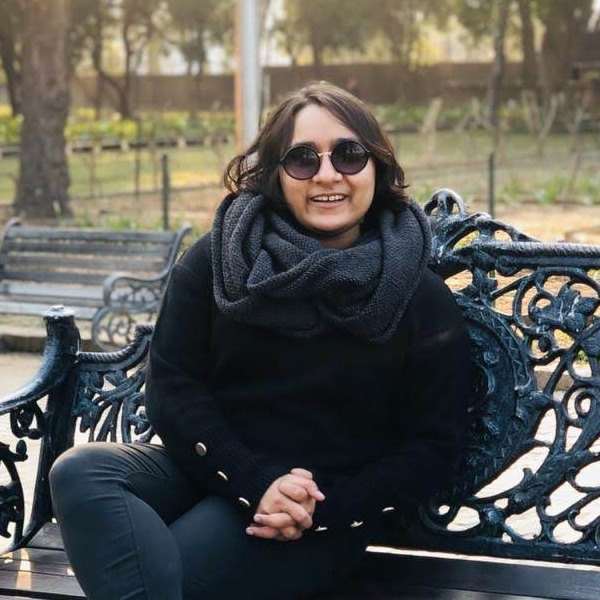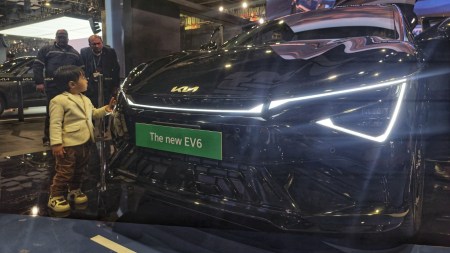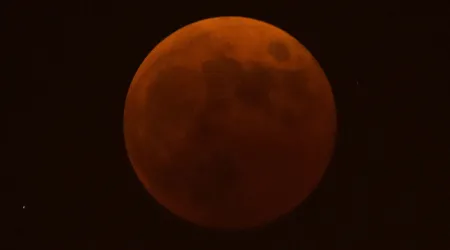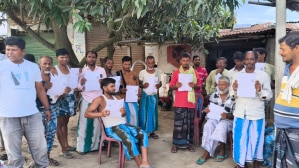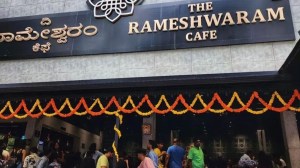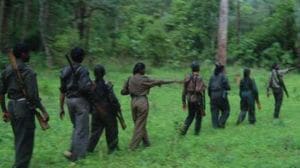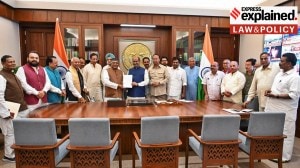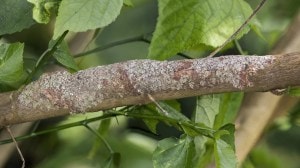UPSC Current Affairs Pointers of the past week | June 9 to June 15, 2025
Worried about your UPSC Current Affairs preparation? Don't miss out on important current affairs tidbits for your Prelims and Mains preparation. Learn about the— World Test Championship, Passage Ex, DIGIPIN, Op Rising Lion, Axiom-4 Mission, Global Gender Gap Index, and more. You can also test your knowledge by solving MCQs.
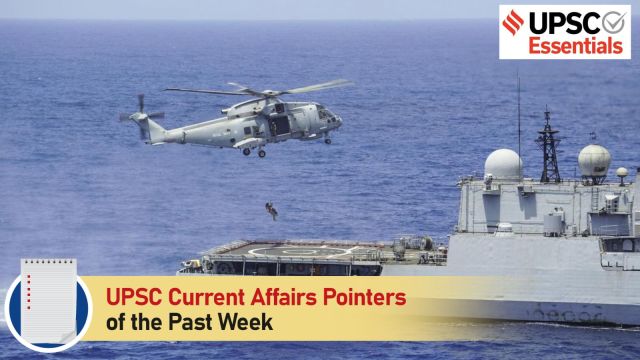 Passage Exercise, a joint naval drill conducted by the Indian Navy and the United Kingdom to enhance maritime cooperation. (Source: X/@indiannavy via PTI)
Passage Exercise, a joint naval drill conducted by the Indian Navy and the United Kingdom to enhance maritime cooperation. (Source: X/@indiannavy via PTI)Every Monday, we bring you UPSC Current Affairs Pointers—a concise, exam-focused guide to help you stay ahead in your Prelims and Mains preparation.
If you missed the UPSC Current Affairs Pointers of the past week | June 2 to June 8, 2025, from the Indian Express, read it here.
Reports/Indices
(FYI: The data provided in these reports can be used to substantiate your Mains answer and create a broad understanding of the topic.)

— United Nations Population Fund (UNFPA) has released the 2025 State of World Population (SOWP) Report titled, ‘The real fertility crisis: The pursuit of reproductive agency in a changing world’.
— The report has called for a shift from panic over falling fertility to addressing unmet reproductive goals. SOWP 2025 underlines that millions of individuals are unable to realise their real fertility goals. This is the real crisis, not underpopulation or overpopulation.
— According to the report, one in three adult Indians (36%) face unintended pregnancies, while 30% experience unfulfilled desire for having either more or fewer children. Financial limitations are one of the biggest barriers to reproductive freedom in India.
— The report finds that one in five people globally expect not to have the number of children they desire. Key drivers include the prohibitive cost of parenthood, job insecurity, housing, concerns over the state of the world, and the lack of a suitable partner.
— Replacement-level fertility, commonly defined as 2.1 births per woman, is the rate at which a population size remains the same from one generation to the next. In India, the replacement-level fertility is 2.0. But, fertility rate remains high in Bihar (3.0), Meghalaya (2.9), and Uttar Pradesh (2.7).
Do you know the difference between fertility rate and total fertility rate (TFR)? In the 2024 UPSC Prelims, a question was asked on the meaning of the total fertility rate.
— The 19th edition of the Global Gender Gap Report 2025 was published by the World Economic Forum (WEF), with the global gender gap at 68.8 per cent for 148 countries.
— India has ranked 131 out of 148 countries in the World Economic Forum’s Global Gender Gap Report 2025, slipping two places from its position last year. With a parity score of just 64.1 per cent, India is among the lowest-ranked countries in South Asia. In 2024, India ranked 129.
— It benchmarks the current state and evolution of gender parity across four key dimensions: Economic Participation and Opportunity, Educational Attainment, Health and Survival, and Political Empowerment. The index lies between 0 and 1, with 1 denoting complete parity.
— Iceland retains the world’s most gender-equal economy for the 16th consecutive year, closing 92.6% of the gender gap – the only economy to reach 90% parity- followed by Finland, Norway, the United Kingdom, and New Zealand.
| India’s performance across the components of the Global Gender Gap Index | ||||
| Components | 2025 | 2024 | ||
| Score (0-1) | Rank | Score (0-1) | Rank | |
| Global Gap Gender Index | 0.644 | 131 | 0.641 | 129 |
| Economic Participation and Opportunity | 0.407 | 144 | 0.398 | 142 |
| Educational Attainment | 0.971 | 110 | 0.964 | 112 |
| Health and survival | 0.954 | 143 | 0.951 | 142 |
| Political Empowerment | 0.245 | 69 | 0.251 | 65 |
Economy
— Rail Vikas Nigam Ltd (RVNL), a public sector undertaking (PSU) of the Ministry of Railways, is in discussion with Russia’s state-owned atomic energy company Rosatom to build Small Modular Reactors (SMRs) to fulfill the energy requirements of its four ongoing mega projects.
— The projects include Rishikesh-Karnaprayag line, Bhanupali-Bilaspur railway line, Yavatmal-Nanded railway line and Indore-Budni Railway line.
— SMRs are advanced nuclear reactors with a power capacity of up to 300 MW per unit and require less area for installation.
FYI: In the Union Budget 2025, the Indian government announced a Nuclear Energy Mission for research & development of Small Modular Reactors (SMRs). Click here to read more.
— India’s copper cathode imports declined 34 per cent year-on-year in 2024-25 (FY25), largely due to a three-month supply disruption triggered by a quality control order (QCO).
— In India, copper is classified as a critical mineral given limited domestic production and high demand in conventional and emerging technologies. It is also considered a bellwether of economic activity due to its extensive application across various sectors.
Polity
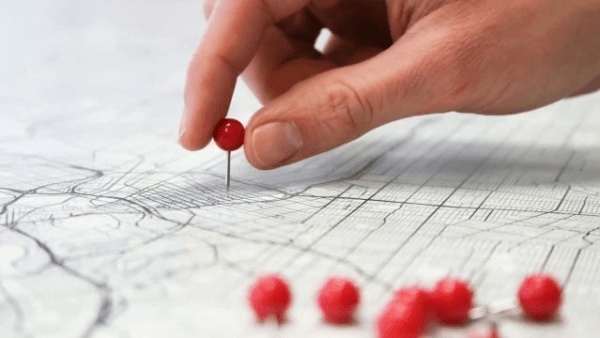 DIGIPIN is a unique ten-character alphanumeric code. (Image: Unsplash)
DIGIPIN is a unique ten-character alphanumeric code. (Image: Unsplash)
— The Indian government has launched a new digital address system called DIGIPIN that aims to enable the precise identification of locations in the country.
— DIGIPIN is a unique ten-character alphanumeric code that can be generated for any property that is approximately 4 by 4 square meters on Indian land. This means that unique DIGIPINs can be generated for nearly all types of properties, including in urban locations and rural areas across different maritime zones.
— The Department of Posts has developed the underlying technology of DIGIPIN in collaboration with Indian Institute of Technology (IIT) Hyderabad and the National Remote Sensing Centre, which works under the aegis of the Indian Space Research Organisation (ISRO).
— Each DIGIPIN is encoded with the geographic coordinates of that property so it does not store any personal information. The DIGIPIN will not replace the traditional six-digit PIN system. Instead, it is intended to act as an extra layer of precision built on top of existing postal addresses.
— The Ministry of Agriculture and Farmers Welfare plans to launch CROPIC, a study to gather crop information using field photographs and AI-based models.
— CROPIC stands for Collection of Real Time Observations & Photo of Crops. According to the plan, crops will be photographed four-five times during their cycle, and the pictures will be analysed to assess their health and potential mid-season losses.
— The CROPIC mobile app has been developed by the Union Ministry of Agriculture and Farmers’ Welfare. The CROPIC model will use an AI-based cloud platform for photo analysis and information extraction, and a web-based dashboard for visualisation.
International
— MSC IRINA, the world’s largest container ship by capacity, docked at Vizhinjam International Seaport, which was commissioned last month. This is India’s first deepwater transshipment port which was commissioned by Prime Minister Narendra Modi last month.
— The port is managed by Adani Ports and SEZ Private Limited under a design, build, finance, operate and transfer (DBFOT) model.
— A transshipment port includes terminals, where cargo containers are shifted from one vessel to another before they reach their final destination. Countries with robust global trade networks tend to use such ports to process large amounts of international cargo efficiently.
— The Vizhinjam port in the Arabian Sea is India’s strategic response to over-reliance on foreign ports for transshipment cargo.
 Built at a cost of around Rs 8,900 crore under public-private partnership (PPP) mode, the Vizhinjam transshipment port is operated by the Adani Group, with the Kerala government holding the majority stake. (Photo Credit: X/PortOfVizhinjam)
Built at a cost of around Rs 8,900 crore under public-private partnership (PPP) mode, the Vizhinjam transshipment port is operated by the Adani Group, with the Kerala government holding the majority stake. (Photo Credit: X/PortOfVizhinjam)
Advantages offered by the Vizhinjam port
(a) The Vizhinjam port’s proximity to the congested east-west international shipping lane just 10 nautical miles away puts it in a prime location to become a major transshipment hub for the Indian subcontinent.
(b) Vizhinjam’s biggest advantage is its natural depth of 18 to 20 metres only a kilometre away from the shore—deep enough for the world’s largest cargo vessels to dock without dredging, a costly and environmentally disruptive process used to deepen shallow ports.
(c) Unlike most Indian ports, Vizhinjam experiences minimal sand movement along the coast (littoral drift), which reduces maintenance costs.
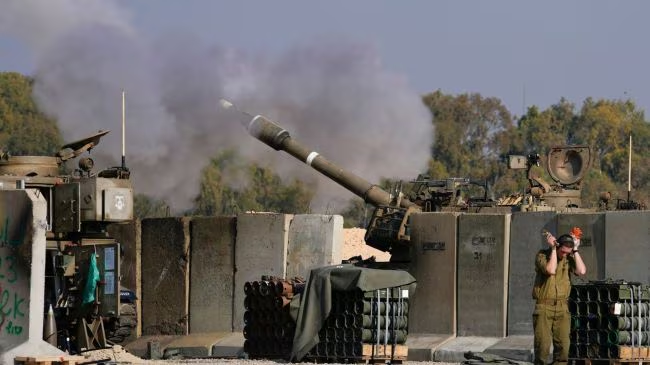 Israel appears determined to roll back Iran’s nuclear and missile capabilities, ignoring global warnings that such an offensive could plunge the Middle East into a wider conflict. (Photo: AP)
Israel appears determined to roll back Iran’s nuclear and missile capabilities, ignoring global warnings that such an offensive could plunge the Middle East into a wider conflict. (Photo: AP)
— Israel launched a military operation against Iran, giving it the codename of Operation Rising Lion.
— In retaliation, Iran launched Operation True Promise 3.
Defence
— The Indian Navy will induct nine to 10 warships in the coming months, with the first of these—the Anti-Submarine Warfare Shallow-Water Craft (ASW-SWC) Arnala—is scheduled for commissioning on 18 June at the Naval Dockyard in Visakhapatnam.
— It was designed and constructed by Garden Reach Shipbuilders & Engineers (GRSE), Kolkata, under a Public–Private Partnership with L&T Shipbuilders.
— Named after the historic Arnala Fort in Vasai, Maharashtra, Arnala is equipped for a range of anti-submarine warfare operations, including subsurface surveillance, search-and-rescue missions, and low-intensity maritime tasks. It is the largest Indian naval warship to be propelled by a diesel-engine–waterjet combination.
- Passage Exercise
— The Indian Navy’s stealth frigate INS Tabar, a submarine, and P-8I maritime patrol aircraft participated in a passage exercise (PASSEX) with the United Kingdom’s Carrier Strike Group in the North Arabian Sea on June 9 and 10.
— The joint exercise demonstrates the deepening cooperation between the Indian Navy and the Royal Navy, showcasing a shared commitment to maritime security and robust bilateral ties.
- Nomadic Elephant
— The 17th edition of India-Mongolia Joint Military Exercise NOMADIC ELEPHANT is being conducted in Ulaanbaatar, Mongolia, from 31st May to 13th June 2025.
— It is an annual event conducted alternately in India and Mongolia. The 2024 edition was conducted at Umroi, Meghalaya.
Environment
— According to the study commissioned by the Brihanmumbai Municipal Corporation (BMC), shows that the level of toxicology indicators at the Deonar landfill is up to four times the permissible limits prescribed by the Central Pollution Control Board (CPCB).
— The Deonar dumping ground at Mankhurd-Shivaji Nagar in Mumbai’s eastern suburbs is the oldest waste dump in the country. It has been operational since 1927, a time when this area had very little human habitation.
— The study analysed the levels of Biochemical Oxygen Demand (BOD), Chemical Oxygen Demand (COD), and Total Dissolved Solids (TDS) — all crucial indicators of environmental toxicology.
— BOD indicates the amount of dissolved oxygen required by microorganisms to break down organic matter present in a water sample; COD refers to the amount of oxygen required to chemically oxidise organic matter; TDS refers to the total concentration of all dissolved substances, including inorganic salts, minerals, and organic matter.
— The Union government has rejected Kerala’s demand to recognise wild boars as vermin under the Wildlife Protection Act. The Center is also not in favour of the state’s demand to remove monkeys (bonnet macaque) from Schedule I to Schedule II.
— Section 11 of the 1972 Act regulates the hunting of wild animals. As per clause (1)(A) of the section, the Chief Wildlife Warden (CWLW) of a state may — if satisfied that a wild animal specified in Schedule I (mammals) has become dangerous to human life or disabled or diseased beyond recovery — permit hunting or killing of such animal.
— As per section 62 of the Wildlife Protection Act, the Union Government can notify any wild animal in Schedule II of the Act (which protects it from hunting), as vermin for a period of time in an area/state.
— An animal is declared vermin when it poses a threat to life and crops. Once declared as vermin, wild boar would lose its protection from hunting, thus enabling the state and citizens to cull the wild boar population to protect against the menace the species poses to life and livelihood.
 Eurasian Otter (Source: Thinkstockimages)
Eurasian Otter (Source: Thinkstockimages)
— For three decades, the Eurasian otter, once an integral part of Kashmir’s aquatic ecosystem, was thought to be extinct in the Valley. However, a rare sighting of the semi-aquatic mammal has now been reported in south Kashmir.
— The otter, which has been globally classified as ‘near threatened’ by the International Union for Conservation of Nature (IUCN), was spotted in the Lidder River in Srigufwara, south Kashmir.
| Lidder River |
| The Lidder River is a tributary of the Jhelum River, which originates from the Kolahoi Glacier, located in the upper reaches of the Pir Panjal range in Jammu and Kashmir. The Jhelum River (252 km) originates from a spring at Verinag near the Pir Panjal and flows through Wular Lake in Srinagar before entering Pakistan. It joins the Chenab near a place called Jhang in Pakistan. |
— The Eurasian otter, locally known as Vuder, was an integral part of Kashmir’s aquatic ecosystem and was abundantly found in the water bodies.
— Over the last three decades, it was not spotted in the water bodies of the Valley, and it was thought to be extinct in Kashmir. The reason for the sudden decline is attributed to increased water pollution and hunting of the mammal for its fur.
— The Eurasian otter (Lutra lutra) is one of the three otter species found in India, alongside the Smooth-coated Otter (Lutrogale perspicillata) and the small-clawed otter (Aonyx cinereus).
Science and Technology
 The Axiom-4 mission is closely integrated with our own space plans, and will provide some critical inputs to the Gaganyaan mission and other missions to follow
The Axiom-4 mission is closely integrated with our own space plans, and will provide some critical inputs to the Gaganyaan mission and other missions to follow
— The Axiom-4 mission, set to carry Indian astronaut Shubhanshu Shukla to the International Space Station, is scheduled to be launched on June 19, said ISRO in a statement.
— Shubhanshu Shukla will create history through the Axiom-4 mission by being the second Indian astronaut to go to space. The other three astronauts are: ESA (European Space Agency) astronaut Sławosz Uznański-Wiśniewski of Poland, former NASA astronaut Peggy Whitson, and Tibor Kapu of Hungary. Notably, the mission will carry the first astronauts from Hungary and Poland to the space station.
— Peggy Whitson will command the commercial mission, and ISRO astronaut Shubhanshu Shukla will serve as pilot. The crew will travel to the ISS on a SpaceX Dragon spacecraft and is scheduled to spend up to 14 days aboard the orbiting laboratory.
— In what may be among the worst aviation disasters in India, an Air India Boeing 787 Dreamliner (VT-ANB) crashed soon after taking off from Sardar Vallabhbhai Patel International Airport in Ahmedabad on June 12.
— The cause of the crash is unclear at this stage. On June 13, one of the black boxes was recovered from the Ahmedabad crash site. Generally, an aircraft consists of two such boxes – the Flight Data Recorder (FDR) and the Cockpit Voice Recorder (CVR).
— A black box is simply a flight recorder, with origins in the early 1950s. In 1963, following two fatal aviation disasters, Australia became the first country to make flight recorders a mandatory legal requirement.
— The film runs continuously in a box that is constructed to prevent any light from entering it, lending it the name “black box”. The name has endured, even as the outer box of the recorder has always been orange – a bright colour that makes it easier to identify the metal case.
Persons in News
(Just FYI: Noting historical personalities’ anniversaries aids UPSC prep. UPSC often includes such personalities in questions, so revisiting their lives refreshes your static syllabus.)
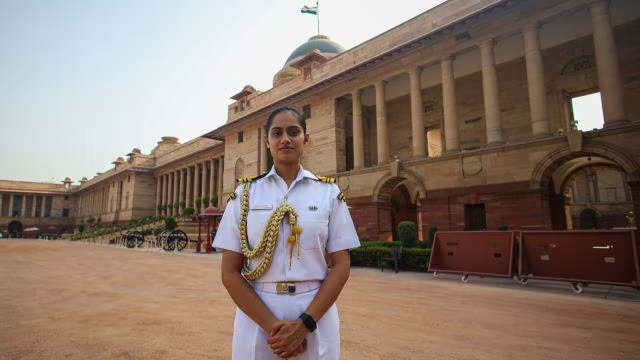 Lieutenant Commander Yashaswi Solankee (Express/Praveen Khanna)
Lieutenant Commander Yashaswi Solankee (Express/Praveen Khanna)
— On May 9, Lieutenant Commander Yashaswi Solankee (27) became the first woman officer to be appointed as an Aide-de-Camp (ADC) to the President of India.
— The President has five ADCs — three from the Army, and one each from the Navy and Air Force — none of them have been a woman officer so far.
— The President’s ADC serves as the bridge to the First Citizen — liaisoning her appointments and call-ons, being present with her at all presidential ceremonies and events, facilitating communication with various branches of the government and military.
Places in News
(Just FYI: The location of the place is important, considering that UPSC has asked several questions about places that were in the news, such as Aleppo and Kirkuk, in the 2018 UPSC Prelims. The best way to remember them is to plot them on a world map.)
 These are the important places that you should know about.
These are the important places that you should know about.
— In what is its most ambitious military operation in recent years, Israel launched a series of air strikes against Iran, targeting nuclear sites, missile facilities and other military infrastructure.
— The Natanz nuclear facility has been attacked. Located roughly 135 miles southeast of Tehran, Natanz is Iran’s primary uranium enrichment site. Partially built underground to withstand airstrikes, the facility houses cascades of centrifuges used to enrich uranium more efficiently. Iran has also been tunnelling into a nearby mountain known as Kūh-e Kolang Gaz Lā (Pickax Mountain) — an effort seen as an attempt to fortify and expand the site.
— Isfahan Nuclear Technology Centre: Roughly 215 miles southeast of Tehran, Isfahan is a hub of nuclear research and development. It hosts three Chinese-built research reactors and employs thousands of Iranian scientists. The site plays a crucial role in training and infrastructure for Iran’s atomic programme.
— Arak Heavy Water Reactor: Located 155 miles southwest of Tehran, Arak is designed to use heavy water as a coolant, a process that can produce plutonium as a byproduct. While Iran has not pursued plutonium-based weapons, Arak theoretically offers a second pathway to a nuclear bomb. As part of the 2015 nuclear deal with world powers, Iran agreed to redesign Arak to reduce proliferation risks.
Sports
(Just FYI: With the unpredictability of the UPSC examinations and questions like the ICC World Test Championship question 2021, you can’t be sure of anything. It is wise to know what it is and not go into too much detail.)
 South Africa’s captain Temba Bavuma holds the winner’s trophy and celebrates with teammates after their win in the World Test Championship final against Australia at Lord’s cricket ground in London, Saturday, June 14, 2025. (AP Photo/Kirsty Wigglesworth)
South Africa’s captain Temba Bavuma holds the winner’s trophy and celebrates with teammates after their win in the World Test Championship final against Australia at Lord’s cricket ground in London, Saturday, June 14, 2025. (AP Photo/Kirsty Wigglesworth)
— South Africa claimed its first International Cricket Council (ICC) trophy in 27 years after beating Australia by five wickets in the World Test Championship (WTC) final at Lord’s.
— The World Test Championship points table is independent of the ICC Test rankings.
— Point system: Each series has 120 points. Accordingly, in a two-match series, 60 points is awarded for a win, 30 points for a tie, and 20 points for a draw. No point is awarded for a defeat.
→ In a three-match series, 40 points are awarded for a win, 20 points for a tie, and 13 points for a draw.
→ In a four-match series, 30 points are awarded for a win, 15 points for a tie, and 10 points for a draw.
→ In a five-match series, 24 points are awarded for a win, 12 points for a tie, and 8 points for a draw.
Test Your Knowledge
(Note: The best way to remember facts for UPSC and other competitive exams is to recall them through MCQs. Try to solve the following questions on your own.)
(1) Consider the following statements:
1. BOD indicates the amount of dissolved oxygen required by microorganisms to break down organic matter present in a water sample
2. TDS refers to the amount of oxygen required to chemically oxidise organic matter
3. COD refers to total concentration of all dissolved substances, including inorganic salts, minerals, and organic matter.
Which of the following statements is/are incorrect?
(a) 1 only
(b) 1 and 2 only
(c) 2 and 3 only
(d) 1, 2 and 3
(2) The total fertility rate in an economy is defined as: (UPSC CSE 2024)
(a) the number of children born per 1000 people in the population in a year.
(b) the number of children born to couple in their lifetime in a given population.
(c) the birth rate minus death rate.
(d) the average number of live births a woman would have by the end of her child-bearing age.
(3) Consider the following statements about Copper:
1. The major deposits of Cooper in India are located in Singhbhum (Jharkhand) and Balaghat (Madhya Pradesh).
2. Antimony, Beryllium, Bismuth, Cobalt, and Copper are classified as critical minerals in India.
3. It can be found in sulphide deposits, in carbonate deposits, and in silicate deposits.
How many of the above statements are correct?
(a) Only one
(b) Only two
(c) All three
(d) None
(4) Consider the following statements in respect of the ICC World Test Championship: (UPSC CSE 2021)
1. The finalists were decided by the number of matches they won.
2. New Zealand was ranked ahead of England because it won more matches than England.
Which of the above statements is/are correct?
(a) 1 only
(b) 2 only
(c) Both 1 and 2
(d) Neither 1 nor 2
| Answer Key |
| 1. (c) 2. (d) 3. (c) 4. (d) |
For your suggestions, write to khushboo.kumari@indianexpress.com
Subscribe to our UPSC newsletter. Stay updated with the latest UPSC articles by joining our Telegram channel – IndianExpress UPSC Hub, and follow us on Instagram and X.
🚨 Click Here to read the UPSC Essentials magazine for May 2025. Share your views and suggestions in the comment box or at manas.srivastava@indianexpress.com🚨
Photos



- 01
- 02
- 03
- 04
- 05

